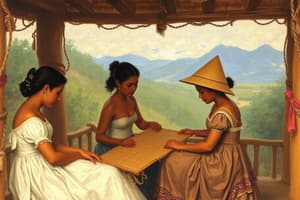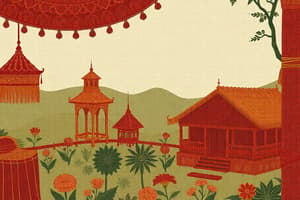Podcast
Questions and Answers
What does Seputangan symbolize in the Yakan culture?
What does Seputangan symbolize in the Yakan culture?
- The dignity of the Bara-bangsa
- The Pangubatan alter set (correct)
- The cultural heritage of Maguindanao
- The Inaul weaving tradition
What is the meaning of the term 'Inaul' in Maguindao?
What is the meaning of the term 'Inaul' in Maguindao?
- A weaving technique
- A cultural festival
- A type of fabric
- Woven (correct)
What materials were originally used by the first Inaul weavers?
What materials were originally used by the first Inaul weavers?
- Sutra threads from spider webs (correct)
- Rayon, cotton, and silk
- Linen and cotton
- Wool and polyester
What is the significance of the Inaul fabric in Maguindanao culture?
What is the significance of the Inaul fabric in Maguindanao culture?
How long does it take to produce a 4-meter Inaul fabric?
How long does it take to produce a 4-meter Inaul fabric?
What is the name of the master weaver mentioned in the text?
What is the name of the master weaver mentioned in the text?
What is the purpose of the Al Jamelah Weaving Center?
What is the purpose of the Al Jamelah Weaving Center?
What is the name of the festival that celebrates the cultural heritage of Maguindanao?
What is the name of the festival that celebrates the cultural heritage of Maguindanao?
What is the origin of Pis-Yabit?
What is the origin of Pis-Yabit?
What is the name of the founder of the Al Jamelah Weaving Center?
What is the name of the founder of the Al Jamelah Weaving Center?
Flashcards
Textile Art
Textile Art
Creating items using fibers from plants, animals, insects, or synthetic sources.
Embroidery
Embroidery
Adding decorative designs to fabric using thread.
Knitting
Knitting
Creating fabric by interlacing yarn with needles in connected loops.
Weaving
Weaving
Signup and view all the flashcards
Sewing
Sewing
Signup and view all the flashcards
Soul
Soul
Signup and view all the flashcards
Imagination
Imagination
Signup and view all the flashcards
T'nalak
T'nalak
Signup and view all the flashcards
Pis-Syabit
Pis-Syabit
Signup and view all the flashcards
Seputangan
Seputangan
Signup and view all the flashcards
Study Notes
Textile Art Overview
- Textile art involves creating items using fibers from plants, animals, insects, or synthetic sources.
- The term "textile" derives from the Latin "texere," meaning to weave or construct.
- Textiles serve various purposes: body covering, social signaling, storage, insulation, decoration, and for softening surfaces.
Historical Context of Textile Art
- Textiles are among the oldest forms of art, with earliest accounts dating back 100,000 to 500,000 years during prehistoric times.
- Early textile creation methods were entirely manual, making the process labor-intensive.
- The Silk Road facilitated the trade of Chinese silk, influencing textile practices in India, Africa, and Europe.
- The Industrial Revolution introduced automation in fabric production through innovations like the cotton gin, spinning jenny, and power loom.
- Artists from the 1960s and 70s began to elevate textile work, moving it from "women's work" to a recognized form of high art.
Key Philippine Textile Art
- A significant textile piece made from Abaca, believed to be a 13th-14th-century death shroud, was discovered in a wooden coffin on Banton Island, marking it as the oldest textile in the Philippines.
Popular Textile Art Techniques
- Embroidery: Adding decorative designs to fabric using thread.
- Knitting: Creating fabric by interlacing yarn with needles in connected loops.
- Weaving: Interlacing two sets of thread to form textiles.
- Sewing: Using needle and thread to make or mend clothes.
- Printing and Dyeing: Techniques for adding color and patterns to textiles.
Concepts of Soul, Dreams, and Imagination
- Soul: Emotional or intellectual intensity expressed in artistic works.
- Dreams: Mental images and emotions experienced during sleep.
- Imagination: The ability to create and experiment, significantly influencing artistic production; can occur both suddenly and deliberately.
T'nalak and T'boli Weaving
- T'nalak: Sacred cloth of the T'boli people around Lake Sebu, Mindanao.
- Weaving Process:
- Kedungon: Harvest and strip abaca fibers.
- Tembong: Connect fibers end-to-end.
- Semdang: Prepare fibers on the loom.
- Mebed: Knot fibers before dyeing.
- Temogo: Dyeing process using natural dyes.
- Hemto: Untie knots to reveal patterns.
- Traditionally employs black, red, and white colors, with designs inspired by a mythical figure.
Dagmay and Pis-Syabit Textiles
- Dagmay: Woven cloth used traditionally as women's skirts and blankets.
- Pis-Syabit: Handwoven cloth by Tausug ethnic group, made from cotton or silk using back strap loom techniques.
- Darhata Sawabi: Renowned Pis-Syabit weaver known for her craftsmanship.
Yakan Textile Art
- Seputangan: Square cloth used by the Yakan tribe as head covering or waistband, featuring complex geometric designs.
- Yakan weavers, particularly Ambalang Ausalin, are respected for their craftsmanship; women trained in warping, designing, and weaving hold esteemed status.
- The Yakan are recognized for their unique weaving style, characterized by off-white backgrounds and square patterns.
Studying That Suits You
Use AI to generate personalized quizzes and flashcards to suit your learning preferences.




